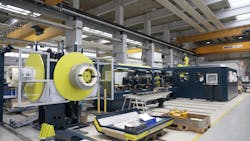How to unlock flexibility and IT/OT convergence with SDA
Key highlights
- While PLCs remain crucial for real-time control, adopting software-defined automation (SDA) offers increased agility, flexibility and the ability to integrate advanced analytics for more adaptable machinery.
- SDA facilitates IT/OT convergence by enabling more standardized interfaces and software-centric systems, potentially simplifying integration and enhancing cybersecurity within manufacturing environments.
- To leverage SDA, machine builders should strategically plan for infrastructure updates and skill development, focusing on open standards and modular designs to create more flexible and intelligent automated solutions.
Rahul Garg is vice president, industrial machinery, at Siemens Digital Industries Software.
What is the primary focus of software-defined automation (SDA)?
Rahul Garg, vice president, industrial machinery, Siemens Digital Industries Software: Programmable logic controllers (PLCs) have been the backbone of industrial automation for decades, providing reliable, real-time control of physical automation equipment and processes. Hardware-centric controllers will continue to be an essential part of your automation architecture, particularly for mission-critical, time-sensitive control applications. At the same time, software-defined automation (SDA) leverages the flexibility and intelligence of software-based control systems, allowing you to adapt more quickly to changing production requirements, integrate advanced analytics and optimization and achieve greater IT/OT convergence.
What are the primary benefits of software-defined automation?
Rahul Garg, vice president, industrial machinery, Siemens Digital Industries Software: The main benefits of software-defined automation include the increase in agility and flexibility it offers, as well as its ability to work with highly complex applications. The ultimate goal is to create a more agile and efficient automation system or systems that can rapidly adapt to changing production requirements while maintaining robust performance and reliability. Yet another benefit SDA offers is the opportunity it provides to work with a larger pool of software engineers. SDA and using artificial intelligence (AI) are two big factors that can attract more software engineers to manufacturing and facilitate innovation.
How does software-defined automation figure in the convergence of IT and OT?
Rahul Garg, vice president, industrial machinery, Siemens Digital Industries Software: IT/OT convergence is a key enabler of software-defined automation. It provides a framework that allows organizations to integrate and manage both IT and OT systems with agility, flexibility and scalability, while enhancing security, operational efficiency and decision-making capabilities. Quite often, a lot of the OT structure is very hardware-specific. Using software-defined systems allows for the ability to work in a much more common way across different platforms and simplifies the integration with IT and OT networks. Another major takeaway is the implementation of secure practices. Using SDA for IT/OT convergence provides a significant increase in cybersecurity.
Which standards and protocols will be affected most or increase/decrease in use because of software-defined automation?
Rahul Garg, vice president, industrial machinery, Siemens Digital Industries Software: Communication protocols such as OPC UA and MQTT will see an increase in importance with the use of software-defined automation. Industrial Ethernet protocols will also increase in importance because of software-defined automation, while network and security protocols such as secure sockets layer/transport layer security (SSL/TLS), Zero Trust security models and 5G and edge-computing protocols will see an increase in software-defined automation driven environments. On the other hand, legacy IT and legacy industrial protocols will likely experience a decrease in use as they are not typically optimized for real-time, secure and cloud-based integrations, which are prioritized in software-defined environments.
Which components will see the biggest impact from software-defined automation?
Rahul Garg, vice president, industrial machinery, Siemens Digital Industries Software: Software-defined automation will complement PLCs. In addition, other impacts software-defined automation can have will be in human-machine interfaces (HMIs), engineering tools, data management systems and security components. The primary shift will be toward more software-centric, flexible and scalable systems that break down the traditional silos between IT and OT, enabling efficient operations, real-time decision-making and better security. As software-defined automation integrates and modernizes these components, it will drive innovation, improve efficiency and deliver more intelligent, automated environments.
In what ways does software-defined automation allow machine builders more flexibility in hardware selection and management?
Rahul Garg, vice president, industrial machinery, Siemens Digital Industries Software: One of the biggest benefits software-defined automation allows machine builders is providing the ability to decouple the hardware and software on your controls and offer more standardized interfaces. With software-defined automation, hardware deficiencies and hardware failures are easier to address. And software-defined automation obviously promotes much easier development of software for your automation needs because now you are using more standard IT-based software capabilities, and it can be used for more IT-based technologies.
Get your subscription to Control Design’s daily newsletter.
How can machine builders prepare for and leverage software-defined automation?
Rahul Garg, vice president, industrial machinery, Siemens Digital Industries Software: There are many ways machine builders can prepare for and leverage software-defined automation. They should begin through strategic planning and developing a roadmap for success. Then they can consider technical infrastructure updates, skill development for getting the right people with the required competencies, a design approach evolution, a business model adaption, an implementation strategy, partner development and quality assurance. If they follow this blueprint, machine builders can position themselves at the forefront of the industry with the understanding they need to transition to software-driven, flexible systems and adopt open standards, modular designs, cloud integration and focus on security and data-driven decision-making.
How does software-defined automation build on existing IT and network infrastructure in factories and plants?
Rahul Garg, vice president, industrial machinery, Siemens Digital Industries Software: Software-defined automation builds on existing IT and network infrastructure in factories and plants by extending and enhancing capabilities already in place. This is where we rely on existing ethernet infrastructure to add more of IT/OT convergence capabilities, cloud infrastructure/cloud platforms when deploying automation software and utilizing existing IT infrastructure for hosting virtual and existing data centers. Data analytics platforms can be added, as well as data integration enterprise platforms like enterprise resource planning (ERP) or manufacturing execution system (MES) software. Automation is a software layer atop a factory or plant’s IT and network infrastructure and provides greater flexibility and ability to leverage intelligence and minimize disruptions in those factories and plants.
Tell us about your company’s state-of-the-art product that involves software-defined automation.
Rahul Garg, vice president, industrial machinery, Siemens Digital Industries Software: Industrial Operations X, our overarching portfolio for industrial production, features our Industrial Edge devices, our MOM portfolio, Insights Hub for IT/OT convergence, Simatic AX and Opcenter X (Figure 1). Industrial Operations X is based on four pillars: software-defined automation; data-driven production; modular operations; and industrial ecosystem. Industrial Edge is a key enabler for software-defined automation. It helps bring solutions faster to market, allows for reusing provided functionalities and can be managed easily. All of these benefits are also available for companies that intend to deploy their own apps on Industrial Edge devices.
Next steps
- Investigate the potential benefits of adopting protocols like OPC UA and MQTT for new or upcoming machinery designs to enhance data exchange and integration.
- Initiate discussions with your IT department to explore current network infrastructure capabilities and identify potential areas for IT/OT convergence in machine designs.
About the Author
Mike Bacidore
Editor in Chief
Mike Bacidore is chief editor of Control Design and has been an integral part of the Endeavor Business Media editorial team since 2007. Previously, he was editorial director at Hughes Communications and a portfolio manager of the human resources and labor law areas at Wolters Kluwer. Bacidore holds a BA from the University of Illinois and an MBA from Lake Forest Graduate School of Management. He is an award-winning columnist, earning multiple regional and national awards from the American Society of Business Publication Editors. He may be reached at [email protected]




